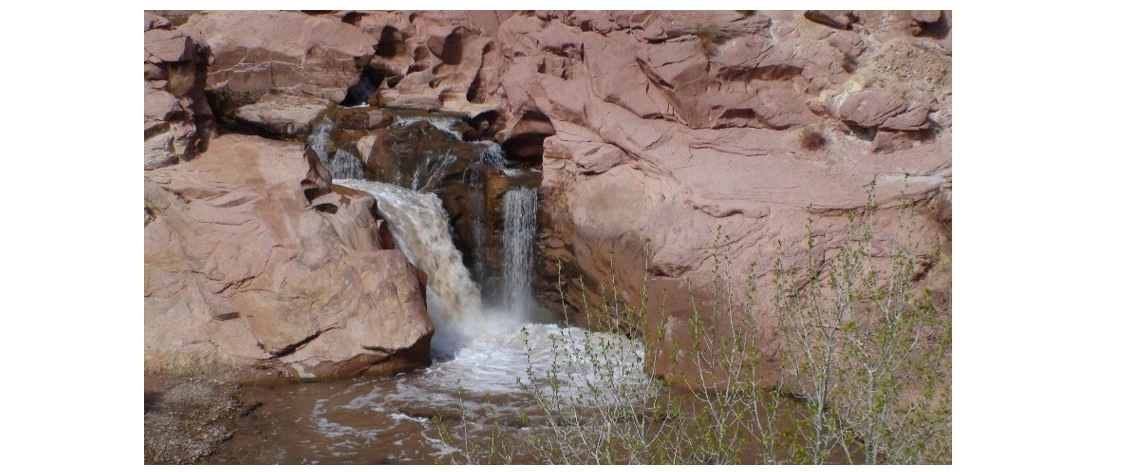Part of a series of articles titled NRCA 2022: Condition of Selected Natural Resources at Capitol Reef.
Article
Assessing the Condition of Fish in Capitol Reef

What kinds of fish live in Capitol Reef National Park?
Four native fish species have been known to inhabit the waters of Capitol Reef National Park (NP): bluehead sucker (Catostomus discobolus), flannelmouth sucker (C. latipinnis), and roundtail chub (Gila robusta), which are species of special conservation status in Utah, and speckled dace (Rhinichthys osculus). Non-native species also occur in the park and include, but are not limited to, redside shiner (Richardsonius balteatus), leatherside chub (Snyderichthys copei), and rainbow trout (Oncorhynchus mykiss). See a listing and description of all native and non-native fish species on the park webpage.
The Fremont River is the principal perennial stream in Capitol Reef NP. Other perennial streams include Sulphur, Pleasant, Oak, Polk, and Halls creeks. Because the park contains only a portion of these perennial streams, they are heavily influenced by upstream activities outside of the park (such as agriculture, vegetation treatments, and water diversions; see next section for more detail). Other than for the Fremont River and, to a lesser extent, Pleasant Creek, there is limited information on the abundance and distribution of fish in park waters.
What threatens Capitol Reef’s fish?
Fish in Capitol Reef may be affected by stressors from outside and inside the park. For example, external influences on fish include climate change (such as temperature stress, impacts to water availability, and flash floods), pollution (such as mercury deposition), and adjacent land uses that can affect water quality and quantity (such was water withdrawals and impacts to hydrologic connectivity [also see paragraph below]). Stressors from within the park may include changes in streamside plant community composition and structure that impact shading and erosion, and some visitor disturbances (such as hiking across streams, causing bank erosion, and swimming).

NPS photo
How do we assess condition of fish species?
A recent Natural Resource Condition Assessment (NRCA) through the NPS NRCA Program focused on a number of resources in Capitol Reef, including fish. NRCAs evaluate natural resource conditions so that parks can use the best available science to manage their resources.For the study, ecologists at Utah State University (our partner for the project) gathered data and information from published and unpublished reports and databases. They used four indicators of condition—biological community (including native and non-native fish occurrence and native fish recruitment), habitat quality, water quality (dissolved oxygen and temperature), and contaminants (mercury and contaminants of emerging concern). The assessment covered the Fremont River and the five creeks mentioned above. However, while data for most indicators were available for the Fremont River, and some data were available for Pleasant Creek, there were few data for the remaining streams.
What did we learn?
Biological Community
- Condition for this indicator in the Fremont River is fair. Most native species were consistently present, but the roundtail chub was absent. The proportion of native fish relative to non-native fish was high (an average of 82% of annual capture from 1992 to 2018 was native fish), but there were several confirmed non-native species in the river, and they were found at multiple sampling locations. The trend in richness and abundance appears stable.
- Sampling of biological communities in other streams in Capitol Reef has been less frequent and represents a data gap.
Habitat Quality
- Habitat quality features in the Fremont River are slightly altered or reduced but are still considered suitable for native fish species; therefore, condition is good/fair. However, confidence is medium (out of low to high) because data were general and not related to the specific needs of each individual species.
- Condition of habitat quality for the remaining streams is unknown due to a lack of data and represents a data gap.
Water Quality
- Data suggest good/fair conditions for the Fremont River and Oak, Sulphur, Pleasant, and Halls creeks. While dissolved oxygen data met standards, temperatures were sometimes elevated in these streams. Temperature exceedances may be more of a concern if temperatures continue to warm due to climate change.
- An average of 15% of samples exceeded Utah’s water quality standards for temperature from 2005 to 2018, with the proportion exceeding standards greater in 2015–2018 than in 2009–2012.
Contaminants
- The overall condition rating for contaminants is fair/poor. Confidence in the rating is medium because not all measures were collected for each stream surveyed.
- Most contaminants of emerging concern (CECs) looked for in water samples from the Fremont River and Sulphur Creek (2012 to 2015) were not found. However, seven CECs were detected in the Fremont River and three were detected in Sulphur Creek, including four pesticides, one drug (caffeine), and four other wastewater indicators (including bisphenol A, found in many items, including plastics).
- Mercury (a heavy metal, not included with “contaminants of emerging concern”) may be affecting fish health in Pleasant Creek and the Fremont River.
What can park managers do with this information and what questions remain?

NPS/Ann Huston
The information obtained in this assessment can be used to inform park planning and management actions that involve the park’s streams and the fish inhabiting them. Although substantial information is available for some of the condition indicators (such as the occurrence of native and non-native species in the Fremont River), the assessment highlighted the lack of information on fish and their habitat in other Capitol Reef streams. Some needs identified include:
- Monitor the recruitment of fish populations in Pleasant, Sulphur, Halls, and Polk creeks using periodic, repeat surveys, especially in Polk Creek (where no data have been collected).
- To manage the park’s native fish, conduct repeat sampling to monitor for streamflow, connectivity, and contaminants (especially mercury).
Last updated: January 11, 2023
